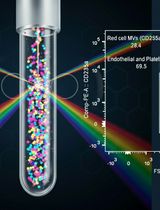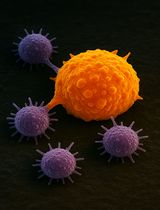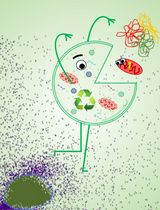- EN - English
- CN - 中文
Multi-color Flow Cytometry Protocol to Characterize Myeloid Cells in Mouse Retina Research
小鼠视网膜研究中骨髓细胞特征的多色流式细胞术方案
(*contributed equally to this work) 发布: 2023年08月20日第13卷第16期 DOI: 10.21769/BioProtoc.4745 浏览次数: 2773
评审: Vivien J. Coulson-ThomasMunenori IshibashiAnonymous reviewer(s)

相关实验方案

外周血中细胞外囊泡的分离与分析方法:红细胞、内皮细胞及血小板来源的细胞外囊泡
Bhawani Yasassri Alvitigala [...] Lallindra Viranjan Gooneratne
2025年11月05日 1197 阅读
Abstract
Myeloid cells, specifically microglia and macrophages, are activated in retinal diseases and can improve or worsen retinopathy outcomes based on their inflammatory phenotype. However, assessing the myeloid cell response after retinal injury in mice remains challenging due to the small tissue size and the challenges of distinguishing microglia from infiltrating macrophages. In this protocol paper, we describe a flow cytometry–based protocol to assess retinal microglia/macrophage and their inflammatory phenotype after injury. The protocol is amenable to the incorporation of other markers of interest to other researchers.
Key features
• This protocol describes a flow cytometry–based method to analyze the myeloid cell response in retinopathy mouse models.
• The protocol can distinguish between microglia- and monocyte-derived macrophages.
• It can be modified to incorporate markers of interest.
We show representative results from three different retinopathy models, namely ischemia-reperfusion injury, endotoxin-induced uveitis, and oxygen-induced retinopathy.
Keywords: Retinopathy (视网膜病变)Background
Retinal injury is associated with activation of microglia and infiltration of bone marrow–derived macrophages and other leukocytes. This immune cell accumulation/activation is known to play a vital role in retinal injury progression and repair. While fluorescent immunolabeling coupled with confocal microscopy imaging of retina flatmounts or sections can be used to assess the retinal immune response, it is often limited by the number of antibodies that can be multiplexed, and quantification tends to be tedious and time-consuming due to the need for staining multiple sections. Furthermore, most myeloid cell markers used in imaging studies such as Iba1 and CD68 are expressed by both microglia and macrophages; also, the markers that are thought to be microglia-specific, such as P2RY12 and TMEM119, can be downregulated in activated microglia, thus complicating interpretation of the results (van Wageningen et al., 2019; Honarpisheh et al., 2020). Alternatively, flow cytometry offers a robust quantitative method to analyze immune cell response in retinal injury models. Using flow cytometry, microglia can be distinguished from myeloid leukocytes based on the relative expression of the CD45 marker coupled with the marker CD11b, where microglia are CD11b+/CD45low while myeloid leukocytes are CD11b+/CD45hi. Furthermore, flow cytometers allow for multicolor staining and hence identification of various markers of interest using the same sample. However, conducting flow cytometry on retina tissue is challenging due to the small tissue size and low cell yield. In this methods paper, we describe a step-by-step protocol to obtain high yield of viable cells and analyze different immune cell populations after retina injury. A panel of antibodies is included to identify the immune cell subsets and myeloid cell inflammatory phenotype using proinflammatory (M1-like) marker, CD11c, and the anti-inflammatory (M2-like) marker, CD206. We present representative flow cytometry results from three different retina injury models—retinal ischemia-reperfusion (IR) injury, endotoxin-induced uveitis (EIU), and oxygen-induced retinopathy (OIR)—that model ischemic retinopathy, uveitis, and retinopathy of prematurity, respectively. The IR and EIU are induced in adult mice and represent two different injury modalities, with the latter leading to a stronger immune response. The OIR model assesses the murine pup’s retina response to hypoxia, which involves vascular regression followed by neovascularization.
Materials and reagents
Ketamine 100 mg/mL (Hikma, NDC 0143-9509-01); note that ketamine is a controlled substance and needs a special Drug Enforcement Administration license to be obtained
Xylazine 100 mg/mL (Covertus, catalog number: 1XYL006)
Sodium chloride for injection vial USP (0.9% saline, 50 mL) (Hospira, NDC 0409-4888-06)
Sodium chloride for injection USP IV bag (0.9% saline, 250 mL) (Baxter, NDC 0338-0049-02)
Bovine serum albumin (BSA) (GeminiBio, catalog number: 700-100P)
DNase I (Sigma-Aldrich, catalog number: NC1539905)
Ethylenediaminetetraacetic acid (EDTA), 0.5 M (Thermo Fisher, catalog number: AM9260G)
Dulbecco’s modified Eagle medium (DMEM), high glucose, GlutaMAXTM supplement, pyruvate (Thermo Fisher, catalog number: 10569010)
Fetal bovine serum (FBS) (Thermo Fisher, catalog number: 10438026)
Phosphate buffered saline (PBS, 10×) (Thermo Fisher, catalog number: 70-011-044)
Hank’s balanced salt solution (HBSS) with calcium and magnesium (Thermo Fisher, catalog number: 14025076)
HEPES buffer solution (Millipore Sigma, catalog number 83264)
LiberaseTM (Sigma, catalog number: NC1179175)
Zombie VioletTM Fixable Viability kit (BioLegend, catalog number: 423113)
Jackson Immuno Research Labs normal rat serum (Fisher, catalog number: NC9834724)
RBC lysis buffer for mouse (Thermo Fisher, catalog number: J62150.AK)
FisherbrandTM round-bottom polystyrene test tubes without cap, FACS tubes (Thermo Fisher, catalog number: FB149563A)
Fluorescent conjugated primary antibodies and unconjugated blocking antibodies (CD16/32) (Table 1)
Table 1. Antibody panel used in this protocol
Antibody Conc. Fluorophore Clone Host Company Catalog # Dilution CD11b 0.2 mg/mL PerCP M1/70 Rat BioLegend 101230 1:100 CD11c 0.2 mg/mL Brilliant Violet 605TM N418 Armenian Hamster BioLegend 117334 1:100 CD206 0.5 mg/mL FITC C068C2 Rat BioLegend 141704 1:100 CD45 0.5 mg/mL Alexa Fluor® 700 30-F11 Rat BioLegend 103127 1:100 F4/80 0.5 mg/mL PE C1:A3-1 Rat Cedarlane CL8940PE 1:100 Gr-1 (Ly-6G/
Ly-6C)
0.2 mg/mL APC RB6-8C5 Rat BD Bioscience 561083 1:100 CD16/CD32 0.5 mg/mL Used as (FC block) 2.4G2 Rat BD Bioscience 553142 1:100
Solutions
Anesthesia cocktail (see Recipes)
Digestion buffer (see Recipes)
Flow cytometry staining buffer (FACS/EDTA buffer) (see Recipes)
Recipes
Anesthesia cocktail
Mix 2 mL of ketamine (100 mg/mL), 0.2 mL of xylazine (100 mg/mL), and 1.8 mL of 0.9% saline to achieve a final solution of 50 mg ketamine and 5 mg xylazine per 1 mL.
Digestion buffer
Supplement HBSS with 5% FBS prepared from frozen stock (triple filtered by the manufacturer through a 0.1 μm filter) and 10 mM HEPES, 0.5 mg/mL of liberase, and 0.1 mg/mL of DNase I. Mix gently for 5 min at 4 °C and keep protected from light until needed. Make sure that the FBS used in the digestion buffer is filtered. If not, filter the entire digestion buffer through a 0.22 μm filter to avoid any cellular aggregation that may occur due to potential debris in the unfiltered FBS.
Flow cytometry staining buffer (FACS/EDTA buffer)
Prepare by adding 1 mL of 0.5 M EDTA to 50 mL of 5% BSA in 1× PBS.
Equipment
BD LSRFortessa flow cytometer; analyzes up to 16 colors (BD Biosciences)
Digital Peri-StarTM Pro peristaltic perfusion pump (World Precision Instruments)
Eppendorf benchtop centrifuges (for 2, 15, and 50 mL tubes at room temperature and 4 °C)
Lab ArmorTM 37 °C bead bath (Fisher)
Invitrogen Countess III cell counter and counting chamber slides (Thermo Fisher)
Bench-top vortex (Fisher)
Dissection tools (World Precision Instruments, catalog number: MOUSEKIT)
General lab supplies: tubes, pipettes, tips, etc.
Insulin syringes (U-30, short needle, 30 gauge) for ketamine/xylazine administration (MHC medical)
Surgical blades, No. 10 (Medline, catalog number: MDS15010)
Weighing balance (Jscale, catalog number: CJ-4000)
30 G needle (TURMO, catalog number: NN3025R)
25 G needle (Air-Titn, catalog number: 830003786)
Hemostat (World Precision Instruments, catalog number: 15920)
Styrofoam or wood surgical station
Software
FlowJo (software package for analyzing flow cytometry data), https://www.flowjo.com/
Procedure
文章信息
版权信息
© 2023 The Author(s); This is an open access article under the CC BY-NC license (https://creativecommons.org/licenses/by-nc/4.0/).
如何引用
Xiao, W., Shahror, R. A., Morris, C. A., Caldwell, R. B. and Fouda, A. Y. (2023). Multi-color Flow Cytometry Protocol to Characterize Myeloid Cells in Mouse Retina Research. Bio-protocol 13(16): e4745. DOI: 10.21769/BioProtoc.4745.
分类
神经科学 > 细胞机理 > 小神经胶质
免疫学 > 免疫细胞染色 > 流式细胞术
细胞生物学 > 基于细胞的分析方法 > 流式细胞术
您对这篇实验方法有问题吗?
在此处发布您的问题,我们将邀请本文作者来回答。同时,我们会将您的问题发布到Bio-protocol Exchange,以便寻求社区成员的帮助。
提问指南
+ 问题描述
写下详细的问题描述,包括所有有助于他人回答您问题的信息(例如实验过程、条件和相关图像等)。
Share
Bluesky
X
Copy link









